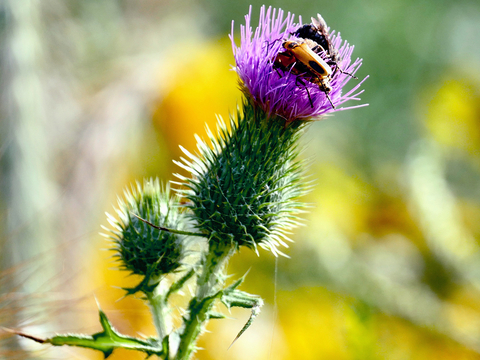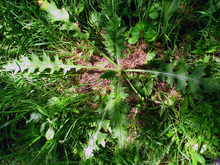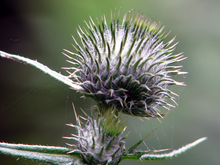Quick facts
Bull thistle is an invasive species.
-
Bull thistle colonizes areas where vegetation, topsoil, or overburden is removed such as road sides, pastures and ditch banks.
-
It can also be found in hay fields, prairies and woodlands.
-
Livestock do not eat it, giving it an advantage over native species.
Bull thistle should be reported. The Minnesota Department of Natural Resources provides detailed recommendations for reporting invasive species.
How to identify bull thistle
-
Bull thistle (Cirsium vulgare) is a biennial herbaceous plant (a type of bull thistle) grows between three to seven feet tall.
-
It forms a four to eighteen inch wide rosette in its first year and blooms in its second year.
Stem
-
Plants bolt in late May.
-
One to several vertical branched stems form in the second year.
Leaves
-
Bull thistle leaves are coarse on top and soft on the bottom.
-
They are deeply lobed, each lobe has a spine at its tip.
-
Spines extend downward from the leaves along ridges of the stem.
-
Leaves are long near the base and diminish in length as they ascend up the plant.
Flowers
-
The flower heads are one to two inches wide and Gumdrop-shaped.
-
They contain hundreds of tiny purple flowers.
-
Each leaf-like structure is tipped with a long, stiff spine.
-
Bull thistle flowers bloom two to three weeks after other thistles.
-
Flower heads can appear as a small clump or solitary at the apex of a stem.
-
Blooms spring to early fall.
Seeds
-
Bull thistle seeds are numerous and straw-colored.
-
The seeds are one tenth to two tenths of an inch long, with plume-like bristles on the tip.
-
They are dispersed by wind.
-
The seeds survive in soil for more than 10 years.
Roots
-
Each plant has a fleshy taproot.
Reviewed in 2019




